September 30, 2015 PTAB Trial Statistics
As of September 30, 2015, the Patent Trial and Appeal Board (“PTAB”) has updated the monthly statistics of the number of inter partes reviews (“IPR”), post-grant reviews of covered business method patents (“CBM”), regular post-grant reviews (“PGR”), and derivation proceedings (“DER”) that have been filed. These stats on progress are shown below, and can be found at:
https://www.uspto.gov/ip/boards/bpai/stats/aia_trial_statistics.jsp
The graph/chart form of these statistics with some explanations can be found here, which includes proceedings and progress statistics:
http://www.uspto.gov/sites/default/files/documents/2015-06-30%20PTAB.pdf
The updates will be coming on a monthly basis.
IPRs Are the Most Filed Petitions
The first regular PGR (not for a CBM) was filed on August 5, 2014. As shown below, there are now 13 PGR petitions that have been filed (2 in FY2014 and 11 in FY2015; 3 filed in August 2015). This should ramp up when more and more patents qualify (must be a first-inventor-to-file patent), and especially if Congress reduces the scope of estoppel (eliminating the “reasonably could have raised” language). Here’s the breakdown of the 3,973 AIA petitions (3,578 are IPR) filed as of Sept. 30, 2015:
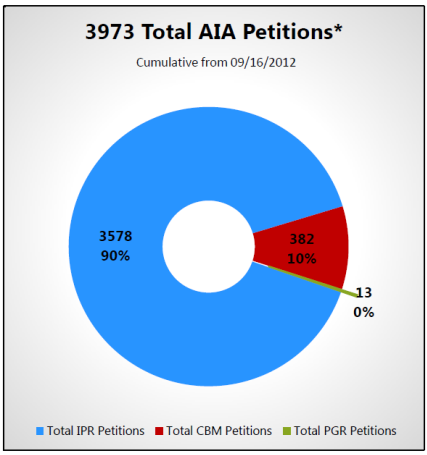
Here is a bar graph version:
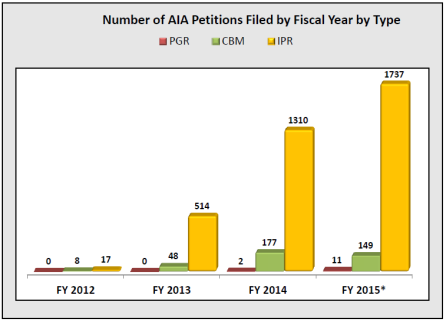
To break down the filing trends for IPR, CBM, and PGR separately on a monthly basis since November of 2012, here are the graphs provided by the PTAB (note that the new fiscal year for the USPTO starts every October 1st) (again as of 09/30/2015). The IPR filings have been steady and relatively high since about April 2014:
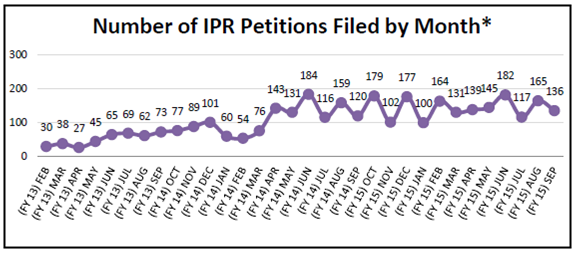
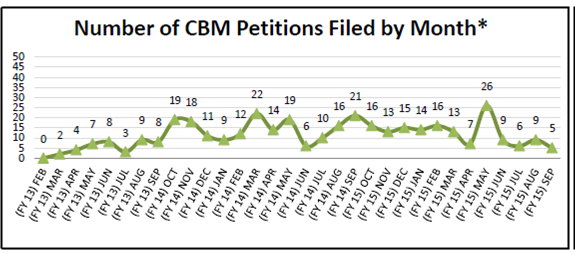
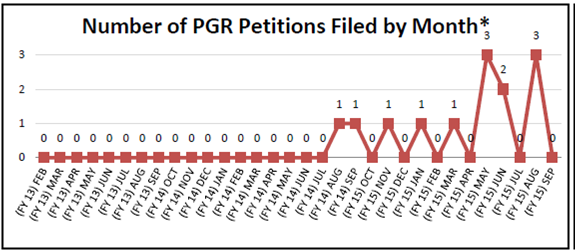
To break down the filing trends for a combined total of all IPR, CBM, and PGR petition filings on a monthly basis since November of 2012, here is the graph provided by the PTAB:
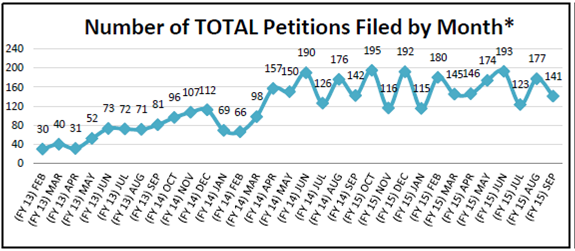
Institution, Disposal, Etc.
For the first phase of an AIA trial, the PTAB determines whether or not an IPR, PGR or CBM will be granted. The PTAB may not authorize the IPR unless the petition and response shows there is a “reasonable likelihood” that the petitioner would prevail with at least one of the challenged claimed.[1] The granting of a PGR/CBM trial requires an initial threshold requirement of “more likely than not”, which may be the same or slightly higher than the IPR threshold standard. However, the latest statistics clearly show that the initial threshold has been met the majority of the time (see the AIA Trials Instituted/Disposals chart below).
Below are charts the filings for IPR, CBM and PGR, respectively, clearly indicating that the majority of filings lead to institution (again as of 09/30/2015):
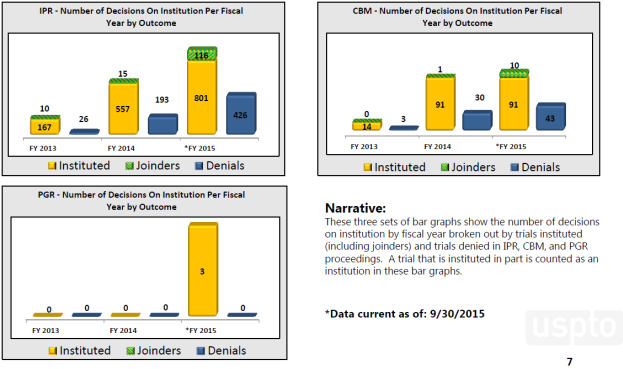
Regarding settlement, that more settlements in IPR pre-institution, whereas in CBM there are more post-institution:

Below is another PTAB chart showing that out of the 2,059 IPR petitions that have been filed, 996 trials are instituted. Of the 1,063 that are not instituted, there is either denial, settlement or dismissal (not clear how many are settled, etc., out of the 1,063; these numbers also do not correspond to the graphs above) (again as of 09/30/2015). The real question is what happens to those claims once there is institution. Of the 996 trials instituted, 575 proceeded to final written decisions, and 414/575 had all claims unpatentable, or 72% (in red below).
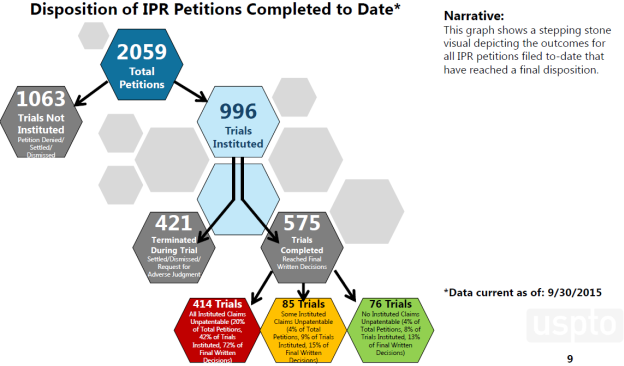
The chart below is for CBM filings (126 out of 242 instituted):
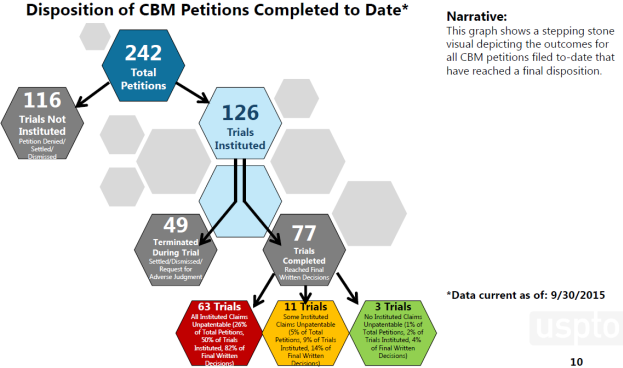
Filings by Technology
The petitions by technology breakdown are shown below, where the majority is still in the electrical/computer/software arts (but bio/pharma has increased, partially due to the hedge fund filings attacking pharmaceutical patents) (again as of 09/30/2015):
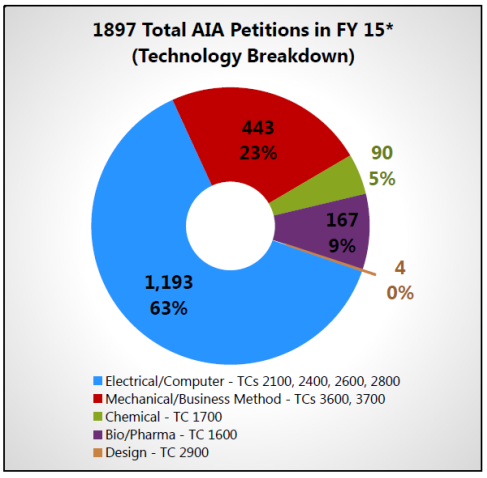
PO Preliminary Responses
During an IPR, PGR or PGR for CBM, the Patent Owner (“PO”) can optionally file a Preliminary Response.[2] Clearly, according to these statistics, the PO is choosing to file a Preliminary Response most of the time (overall 85.8% for IPRs in FY 2015). The number of filed PO Preliminary Responses is in the next chart (again as of 09/30/2015):

Termination
Below is a graph showing how these trials eventually end (again, as of 09/30/2015):
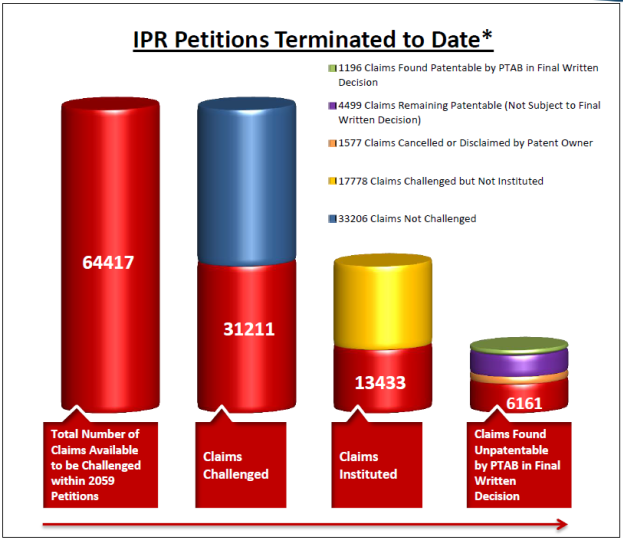
Left, red bar: total number of claims available that could be challenged in the IPR petitions filed.
Second most-left, blue and red bar: Blue indicates those claims not challenged; red are those claims challenged (31,211 claims).
Second most-right, yellow and red bar: Red are those claims going to trial (out of those in the second most-left, blue and red bar; corresponds to the 13,433 claims); yellow are claims challenged but no institution.
Right, multi-colored bar: See description above. A completed petition includes a final written decision, denial of institution, settlement, request for adverse judgment or dismissal. Here, the purple likely indicates termination due to settlement, adverse judgment or dismissal, where there was no final written decision (FWD). Green are those claims found patentable in a FWD (1,196 claims out of 13,433 claims instituted).
Here is the CBM version (in the right bar, the green part looks relatively smaller, the purple part bigger, and the red part bigger compared to IPR):
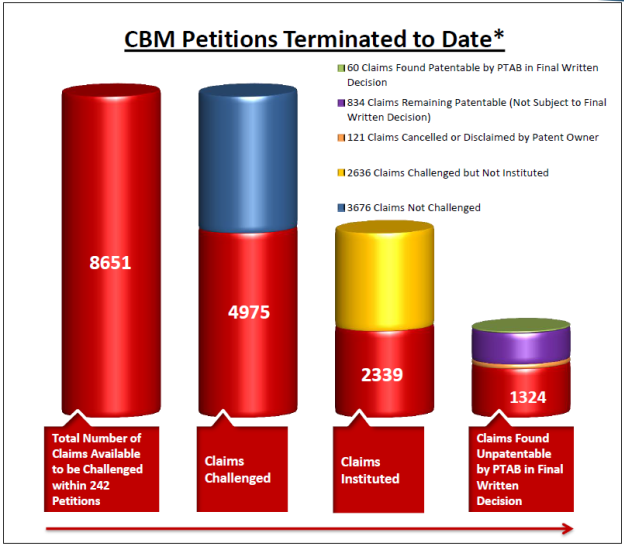
- 77 Fed. Reg. 48764 (Aug. 14, 2012).
- Id. at 48756.

